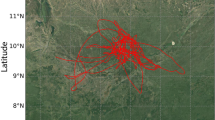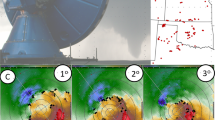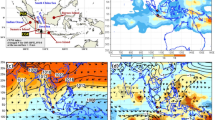Abstract
IN a letter in Nature in 1946 Sir Nelson Johnson1 reported some results of direct measurements of winds at 30 km. by means of observations of shell bursts. Exploration to this height by means of sounding balloons has recently become possible through the development of balloons of large size. Measurements of wind structure are made by radar tracking, and temperature observations are given by radio sonde technique. Seven successful ascents have been made at stations in the south and east of England; five of them were made in midsummer and at night, thus avoiding possible temperature errors due to solar radiation. The other two were day-time ascents in spring, and were confined to wind measurements only. The results of two of the soundings are illustrated in the accompanying diagram.
This is a preview of subscription content, access via your institution
Access options
Subscribe to this journal
Receive 51 print issues and online access
$199.00 per year
only $3.90 per issue
Buy this article
- Purchase on SpringerLink
- Instant access to full article PDF
Prices may be subject to local taxes which are calculated during checkout
Similar content being viewed by others
References
Johnson, N. K., Nature, 157, 24 (1946).
Whipple, F. J. W., Quart. J. Roy. Met. Soc., 61, 285 (1935).
Gowan, E. H., Proc. Roy. Soc., A, 190, 219 and 227 (1947).
Bjerknes, J., and Palmen, E., Geofys. Pub. Oslo, 12, No. 2 (1937).
Palmen, E., J. Met., 5, 20 (1948).
Hess, S. L., J. Met., 5, 293 (1948) See also Met. Mag., 78, 102 (Fig. 2) (1949).
Author information
Authors and Affiliations
Rights and permissions
About this article
Cite this article
SCRASE, F. Wind and Temperature Mesurements up to 30 Km. Nature 164, 572 (1949). https://doi.org/10.1038/164572a0
Issue date:
DOI: https://doi.org/10.1038/164572a0



